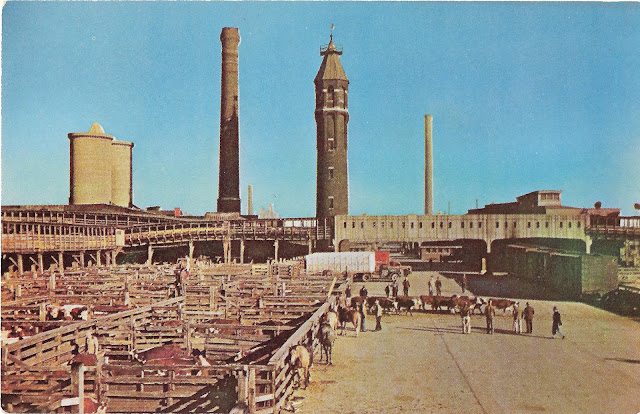 |
| The Union Stock Yards were the largest stockyards in the U.S. and received about 45,000 cattle, 75,000 hogs and 50,000 sheep daily. Published by Gerson Bros. |
 |
| Many of the animals arrive at the stockyards on railroad cars. Publisher name unknown.  Cows graze under an elevated station near the stockyards while people watch them. Publisher name unknown. |
Depending on the direction of the wind, a dreadful stench from the animals at America’s largest stockyards would blow across certain parts of the city, even all the way to Cicero Avenue on the Southwest side, my grandparents told me.
Journalist and author Upton Sinclair’s book The Jungle
described the deplorable conditions there and helped influence policymakers to
pass the federal Pure Food and Drug Act and Meat Inspection Act of 1906. The Union Stock Yards, which opened on Christmas Day
of 1865, were without a doubt built in an ideal Midwest location that was close to farm country and was at a crossroads for train traffic and vehicles.
The site also became a huge tourist attraction, with about 500,000
people visiting the stockyards and packinghouses in the middle of the 20th
century, according to sources. The Union Stock Yards closed on August 1, 1971, after operating for over a century. The site is an industrial park
today, but the famous limestone stockyard entrance still stands.
Numerous postcards of the stockyards were printed for tourists. They make up a popular category for postcard collectors today. I currently have four postcards of the stockyards in my collection.
The three postcards with white borders (like all postcards
with white borders) were printed from 1915 to 1930. Publishers decided to use
white borders to help save ink. The other
postcard is likely from the 1950s and was colored by a postcard artist. I hope you
enjoy the images, and please share your stories about the stockyards and other similar postcards on this blog.
 |
| The Union Stock Yards extended from 37th Street and covered a total area of about 500 acres. Published by Max Rigot Selling Co. |
 |
| This postcard is from the 1950s. "Chicago is the greatest meat-packing city in the world" is printed on the back. Published by Colourpicture. |
 |
| The stockyards receive over 1,000 cars of stock per day from 22 states. Published by Curt Teich & Co, Inc., of Chicago. |
Brings to mind this classic Chicago commercial:
ReplyDeletehttps://www.youtube.com/watch?v=yHUrHCOYGpA